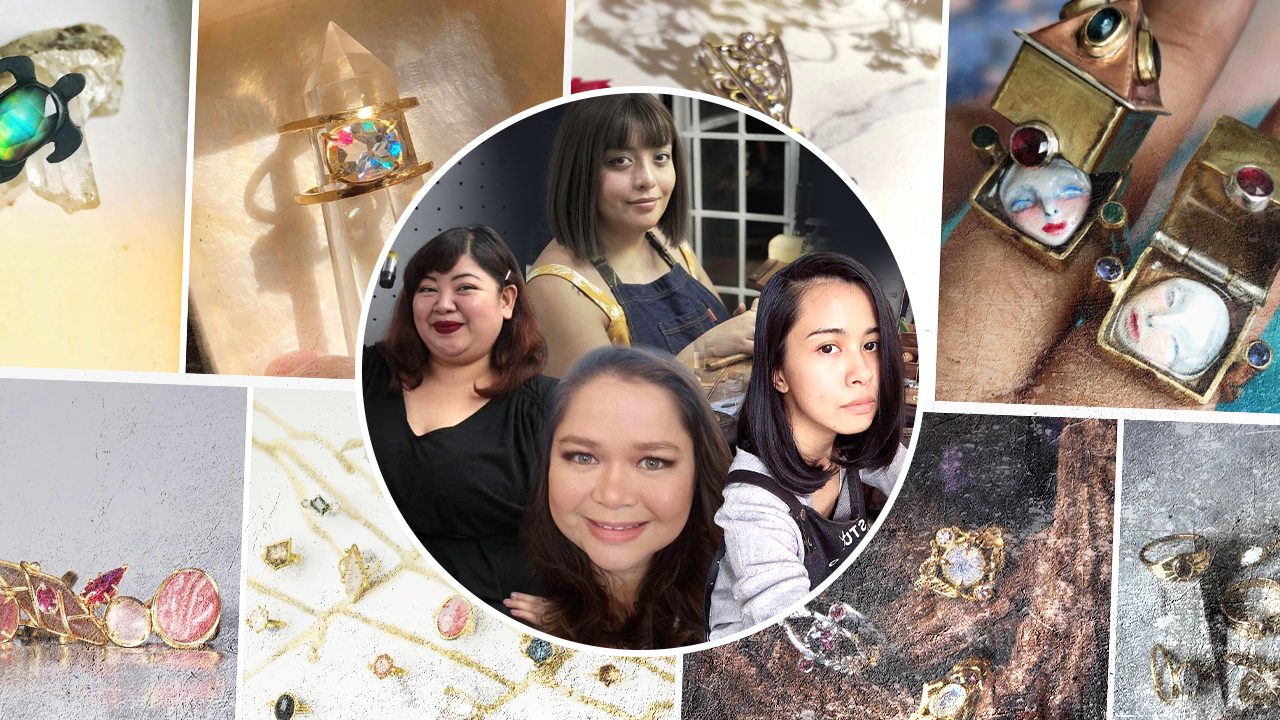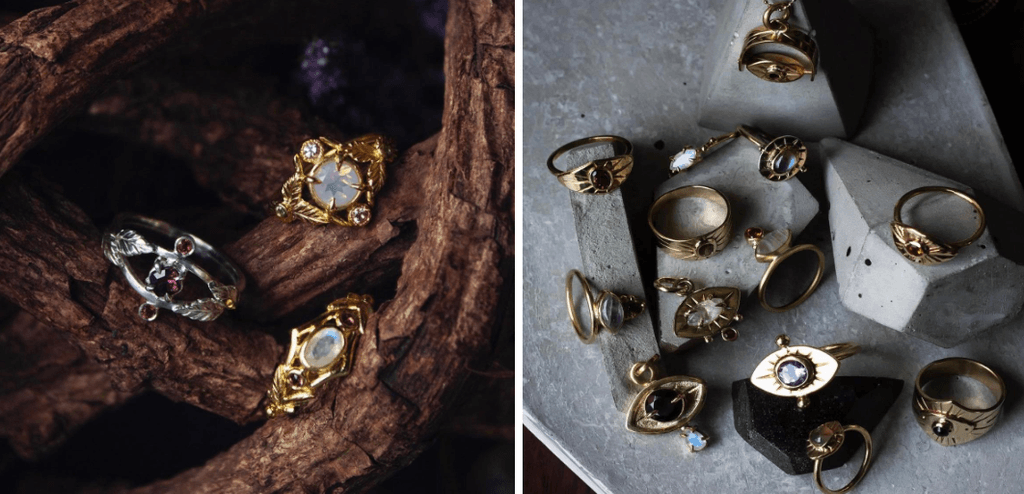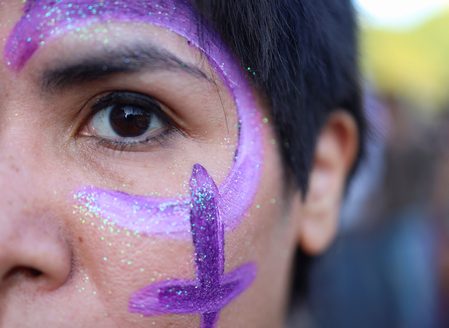SUMMARY
This is AI generated summarization, which may have errors. For context, always refer to the full article.

Janina Arias didn’t exactly have women empowerment in mind when she first built Studio 925 with her best friend and business partner Pat Peralta; she just wanted to make smithing more accessible to Filipinos.
But since opening in 2015, Arias noticed that a large chunk of her students were made up of women. What started out as a group of women learning how to smith soon turned into a thriving community where women smiths shared industry tips and tricks, traded gemstones and metal, and supported each other’s jewelry businesses.
More importantly, it was a collective where no woman was left behind. And so, without meaning to, Studio 925 forged new opportunities for Filipina smiths.
Forging new opportunities
When the studio started gaining more students, Arias decided that it was time to look for apprentices who could help her out with teaching.
For former apprentice Mai Evangelista, Arias’ offer to take her under the studio’s wing was nothing short of pure luck.
“When I got the message that they were offering an apprenticeship, I knew already, ‘Oh crap, if I accept this, my life is going to change’,” Evangelista shared.

Evangelista had already completed Studio 925’s metal etching class but couldn’t afford their other classes. She decided to learn from home and make do with what she had.
If a person wanted to learn how to smith on their own, they would have to buy their own raw materials, equipment, and forging station. The forging station and equipment alone would amount to about P55,000, depending on the brand and availability of materials.
Compared to learning from home, learning smithing is cheaper in studios where workbenches, forging stations, raw materials, tools, and instructors are readily available.
“Talagang kung ano lang yung meron ko sa bahay, pinagtiyagaan ko siya (I just really made do with whatever I had around the house),” shared Evangelista.

Studio 925 offers two kinds of classes for beginner smiths – an introduction to silversmithing with three levels costing P4,800 each, and a project-based class for beginners where students could choose to make either a set of bangles (P5,150) or a pair of hoop earrings (P4,800).
Intermediate smithing classes have three levels, each focused on a specific process of smithing: flush setting (P6,300), bezels and detailing (P19,500 or P3,250 per session), and filigree work (P25,000 or P1,923.08 per session).

When Evangelista became Arias’ apprentice, she spent most of her days hammering away at their studio because she couldn’t afford to invest in proper tools for her own home studio just yet.
“Doon na ako tumira (I basically lived there). They were kind enough to let me use their equipment and their tools,” she said. Now, Evangelista has her own home studio and jewelry business called Fake Alchemy.
Evangelista was right – her life really did change when Studio 925 took a chance on her.
“Before, it was just something that could happen. But then it was happening in front of me literally every day, and I thought it was amazing. And suddenly, I have all these possibilities,” Evangelista said.
All that glitters is not gold
Despite the doors that Studio 925 had opened for women smiths, stereotypes surrounding women are still painfully present in the Philippine smithing industry.
When one hears the word “metalsmith,” the average Filipino would likely think of Bong Revilla, who played the titular role in Ang Panday, a popular film featuring a metalsmith as its protagonist.
“When you think about metalwork, it’s men. Ako naman, naisip ko, bakit hindi babae? Kasi babae naman nagsusuot niyan (But I thought, why not women? It’s the women who wear the final output),” said Vera Juan, the one-woman team behind Vera Metals.

Just like Arias, Juan comes from a family with a long history in jewelry. Her parents and both sets of her grandparents owned jewelry businesses, and Juan is a third-generation jeweler. Like Arias, she is also the first smith in their family and also spent her childhood inside their workshop.
“Doon ako tumatambay, ang dumi-dumi ko na pag-uwi ko, (I’d hang out at the workshop and would come home so filthy),” she joked.
All of Juan’s family’s plateros are men. When Juan, now an adult, asked their plateros to mentor her, they expressed doubt.
“Sabi nila, ‘Baka mahirapan ka kasi babae ka’,” Juan recalled. Whenever she’d ask them for help with gold-plating and polishing pieces, the usual comment would always be, “Kung lalaki ka lang, ang galing mo na (You would have been so good already if you were a guy).”

Arias connects these microaggressions to two factors: the craft’s inaccessibility to women and the country’s traditional gender stereotypes.
“For the longest time, inaccessible yung craft, especially to women. Traditionally natatrain mga lalake (it’s the men who are trained) because it’s also very hard work,” she says.
Although Studio 925 has certainly made smithing more accessible to Filipinas, the second factor contributing to prejudice against women smiths is much more difficult to dismantle: the Philippines’ long-standing gender stereotypes.
“May judgment agad na kasi babae ka, mahihirapan ka maging platero (There’s an immediate judgment that just because you’re a woman, you’re going to find smithing difficult),” said Juan.
Evangelista looks back on a particular session where she and her students had food delivered while working on their projects. When the delivery man saw them working with their tools, he asked them, “Huh, mga babae (women)?”
“There was this dumbfounded look on his face, just staring,” said Mai wryly.
Over the years, they’ve grown accustomed to the way people react when they see them work with their tools or find out what they do for a living, but it also gets tiring.
“I want people to change their mind about this field,” said Juan. “Sana makita din ng mga traditional na platero from generations before me na wala naman pala pinipili ‘to na gender (I hope the older generations of smiths finally see that the craft knows no gender).”
But they don’t want to be defined by their womanhood as well – they just want to create art without having their capabilities questioned or praised because of their gender.
“Hindi rin ako masyado natutuwa kapag bilib na bilib sila na, uy, babae yan (I’m not crazy either about the fact that people are amazed by us just because we’re women),” shared Juan. “Ayoko actually ma-distinguish na (I don’t want it to be pointed out that) it’s because I’m a woman that I can make good things. Can’t I just make nice things?”
A glimmer of hope
The women of Studio 925 have each other’s backs, despite owning businesses in a competitive industry.
“Ang dami na ngayon women supporting women na mga shop. Dumadami na, kaya nakakatuwa (There are so many shops now where women support women. They are growing in number, and it’s really heartening),” said Margaret “Mogly” Sarmenta, one of the studio’s students, who sells her jewelry on her Instagram shop moglycreations.

Whenever someone releases a new collection, they make sure to spread the word. Some of them trade raw materials, and some of them catch up over merienda in their favorite coffee shops.

“We’re all starting in this foreign field. Onti lang kami eh, so kami-kami din lang (There are only a few of us, so it’s really just us). It just happened by accident,” said Evangelista.
If she studied smithing in another studio full of men, Evangelista believes she would have felt really small and questioned whether she belonged there.
Without even meaning to, they forged bonds while hammering away at the studio that brought them together.
“Hindi lang siya school for us eh, naging friends talaga kami. May bond. (It’s not just a school for us, we all became true friends. There’s a bond.) If you’re friends with the people you work with, gusto mong makita mag-grow kayo sabay-sabay (you want to grow together at the same time),” said Kris Carlos, one of Arias’ former students-turned-instructors. Carlos’ Instagram account Thingamabobs features quirky, out-of-the-box jewelry and art for sale.

Since Studio 925 opened, Arias has had more and more women students, each coming from different backgrounds – moms, beginner artists, burnt-out corporate workers, or, at one point, a female pilot who simply wanted to try smithing.

“I do think we’re doing something pretty great here. Just a few years ago, wala ngang ganitong (there wasn’t this kind of) community at all,” said Evangelista. “Studio 925 made smithing accessible for so many people, especially women, since it’s a women-owned workshop. The women weren’t afraid to explore.”
Some of them, like Evangelista, Juan, Sarmenta, and Carlos, eventually pursued careers in smithing and made names for themselves. For Evangelista, it matters that women smiths are getting more visibility these days; not just for women like them, but for the entire smithing industry.
“Bakit walang (Why are there no) great female pianists in the leagues of Mozart, Beethoven? It’s because they weren’t even allowed to play the piano. If they created great work, no one listened to them,” she says. “Now, since people are aware, I feel like it’s opening doors for even more women. It’s creating a community. It’s going to create a thriving jewelry industry.”

To mothers like Juan and Sarmenta, an industry that’s inclusive to women makes sure that kids are free to dream about whatever they want to be when they grow up.
“Ayoko ma-experience ng ibang batang babae na gustong mag-try ng ganitong klaseng work. Imagine mo bata pa lang na makarinig na ng ‘Eh, panlalake yan!’ You just crushed that little girl’s dream,” said Juan.
(I don’t want young girls to experience being held back from this kind of work. Imagine being so young and being told that something’s only for boys.)
Smithing is a man’s world, sure, but Arias reckons that Filipina smiths have found their space in the industry again. “We really had to weasel ourselves back in lang,” she said.
And even though Arias didn’t exactly have women empowerment in mind when she first built Studio 925, this inconspicuous studio in Makati turned into a space where women could form bonds, hone their craft, and forge their dreams into reality. – Rappler.com
Add a comment
How does this make you feel?

There are no comments yet. Add your comment to start the conversation.